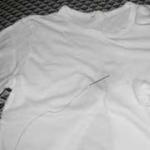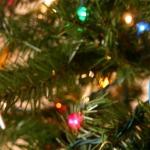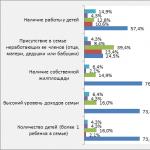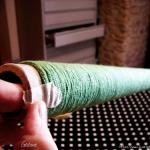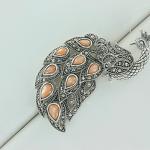Mathematics in the middle group Teacher of the 1st qualification category Zhuravleva S. Summary of an open lesson on femp in the middle group “number four Number 4 middle group
Tatyana Ledyaeva
Abstract open class according to FEMP in the middle group “Number four”
Notes on FEMP in the middle group"Number 4"
Prepared by T. A. Ledyaeva, teacher of the joint venture GBOU secondary school No. 1 "OTs" p. Bolshaya Glushitsa nursery No. 3 "Little Red Riding Hood"
Subject: « Number 4» .
Program content:
Introduce education numbers 4 and the corresponding number;
Learn to name numerals from 1 to 4; count and arrange objects with the right hand from left to right;
Practice orientation in space.
Material support:
4 hoops containing cards with numbers from 1 to 4;
numeric cards according to the number of children;
Bunnies and carrots, cut out of paper, 4 pieces for each child;
Numbers from 1 to 4;
The teacher greets the children and tells the topic classes.
1. Organizational moment.
Educator. The bunnies went out on the road for a walk. Let's get them let's count: one, two, three - 3 bunnies in total (makes a circular gesture). The teacher asks 2-3 children to count how many bunnies have come running. (Children count, touch each hare, and at the end trace 3 hares with their finger).
Then another hare came running. There are more hares. Let's count how much it has become hares: one two Three, four – total 4. There were 3 hares, another one came running, there were 4 hares.
Number 4 is indicated by the number 4 (the teacher shows the number).
Number 4 surprises everyone:
Arm bent at the elbow
Never lets down.
Numbers 1 are displayed on the board; 2; 3.
The number 4 should come after the number 3.
2. Didactic game “What’s missing?”
Now the numbers will play hide and seek with you. Children close their eyes, and the teacher removes any number. Children open their eyes, called "missing" number and put it in a row.
What number is missing? (Answers children: no more numbers)
3. Physical exercise.
One, two - it costs a rocket
Three, four - blown away.
One, two - clap your hands,
And then on every account.
One two Three, four and walked around.
4. Working at tables.
The teacher shows the number "3" and asks the children to put it on top "shelf" cards as many bunnies as the number they see on the card.
How many bunnies did you put in? Why? (Children's answers).
(Three bunnies, since they showed the number 3).
The teacher shows the number "2" and asks the children to put as many carrots on the bottom shelf of the card as the number they see.
What number should be placed next to the hares and carrots? Why this number?
5. Outdoor game "Bunnies".
Rules of the game: You are bunnies, hoops are minks.
Each hole can accommodate as many bunnies as the number written on the card. You will jump on the lawn; When the tambourine rings, all the bunnies hide in their holes.
Praise children for their work.
What number did you meet?
Mathematics in the middle group
Teacher of the I qualification category Zhuravleva S.V.
Topic: Consolidation of what has been learned. Number and figure 4.
Program content:
Practice quantitative and ordinal counting, continue to learn how to correlate the numeral with the number of objects in the group;
Strengthen the ability to distinguish numbers 1-4
Strengthen children's understanding of geometric shapes;
Strengthen the ability to compare the number of objects in a group;
Improve the ability to navigate in space, compare objects by length;
Practice counting, strengthen counting skills in order;
Continue to teach how to equalize unequal groups of objects, alternate objects by color;
Promote the development of mental operations.
Develop positive emotions, promote motor activity children in class;
Cultivate restraint, attentiveness, and the ability to work together in a team.
^ PROGRESS OF THE CLASS:
Organizing time. Ordinal and quantitative counting. Game “Place the carriages in order”, Game “Seat the passengers”.
Remember how inquisitive and attentive this engine is, and it seems to me that he will be our assistant on the journey.
Oh, what happened to him this time (on the easel is a model of a steam locomotive with scattered carriages) we can’t go like that, we urgently need to help the engine put the carriages in order.
I wonder which carriage should come first? Let's count the cars (four). Which one will be first? Second? Third? The last one? Look, we're not the only ones planning to go on a trip. Who's with us? (King One, Queen Two, Princess Four and the victorious warrior Three) What carriage do you think they will travel in? And in which carriage the animals will travel (1 bear, 2 bunnies, 3 squirrels, 4 hedgehogs). Children count the number of animals in the picture and place the picture next to the carriage indicating the number of animals.
^ Game motivation.
^ Soundtrack: Attention, attention! The little engine from Romashkovo goes to the fairytale forest! They sing the song of the little engine from the film “Locomotive from Romashkovo”
Good in the world! Sunshine, shine,
Wish us, wind, a good journey!
Bon, bon, bon voyage,
Very, very good journey!
^ Orientation in space. Didactic games: “Which train is longer”, “What geometric shapes is the train made of?”
"High! Low! Far! Close! Left! On right! Wide! Narrowly!"
^ Stop "Fairy Forest". Psycho-gymnastics “Flowers”
Now tell me: how many flowers grew in the meadow? (8) What color are they? Let's try to make an alternating path of flowers. (children build a path on the floor from daisies and bells)
Can you show how flowers grow?
Game "Flower" (Psycho-gymnastics are carried out. Music is played. Children depict how flowers grow.)
^
Clench your fists and press them together
The flower grows and rises (straighten fingers)
Its petals open (we place our palms like a bowl and open our petal fingers)
^ Game "Listen-Count-Count"
Do you guys hear any sounds? Who sings so wonderfully? (nightingales) (Come closer to the board with pictures of trees). Do you want to know how many nightingales there are on a tree? Listen carefully how many times I clap, that’s how many nightingales need to be planted on a tree. (repeat 3 claps, 2 claps, 5 claps, children sit the birds next to the birch, poplar, spruce)
Physical education minute.
The train is rushing, the train is rushing - hand movements;
Knock-Knock - walking in place;
The heart beats joyfully - hand movements;
Knock-Knock - hand movements from the heart;
Train, train, hurry up - hand movements;
Knock-Knock - walking in place;
Brake on the platform
Knock-knock-stop.
^ Mystery. Massage with a hedgehog ball
Angry touchy-feely
Lives in the wilderness of the forest.
There are a lot of needles
And not just one thread. (Hedgehog)
Look how many hedgehogs I found in the clearing, (count) let's play!
^ The hedgehog is exhausted -
He carried apples and mushrooms. (rolled in palms)
We'll rub his sides -
You need to knead them slightly (knead them)
And then we'll stroke the legs,
To rest a little. (roll over palm)
And then we’ll scratch the belly (click on the “thorns”)
The hedgehog ran away into the woods (rolled in palms)
He squeaked thanks to us.
^ The last clearing. Surprise moment.
Guys, where does this forest path lead, through the swamp? You need to go over the bumps correctly (numbered to four) so as not to get stuck in the swamp, and jump over the stream. (they walk one after another, find a chest - there are emblems with a drawn train there). Well done boys! Everyone was friendly today, did a good job, and even found a treasure! Our journey is coming to an end. Think about why it's time for us to return? Let's go back to kindergarten and then we’ll see what’s locked in the chest.
Final part. Bottom line.
Why did the train bring us to the forest? What were we doing in the forest clearing? Did you enjoy our trip?
Children receive emblems as a souvenir of the journey - the helpers of the engine from Romashkovo.
Summary of GCD in mathematics in the middle group
“Introduction to number and number 4. Consolidation of geometric shapes and ordinal counting up to 3”
Integration educational areas : “Cognition” (formation of elementary mathematical representations, educational and research activities), " Physical Culture", "Communication", "Socialization".
Types of children's activities : gaming, communicative, educational and research.
Goals : practice counting up to 4, teach ordinal counting up to 4; fix the names of geometric shapes; develop spatial orientation; teach to perform actions when given a signal.
Planned results : has a basic understanding of ordinal counting up to 4, an understanding of geometric shapes; retains the required condition in memory when performing mathematical operations and acts with concentration for 15-20 minutes; participates with interest in outdoor games.
Materials and equipment : toys: three bears and Masha doll, doll dishes,numbers, counting sticks, geometric figures.
Contents of organized children's activities
Organizing time.
Guys, let's say hello to each other.
Hello! You tell the person.
Hello! He will smile back.
And he probably won’t go to the pharmacy.
And you will be healthy for many years.
Let's wish each other health and say hello.
Game "Wonderful bag"
The bag contains different three-dimensional geometric shapes. Children take turns putting their hand into the bag, determining the shape of the object, calling it and taking out the shape. The rest of the children check whether the form is named correctly.
While looking at the picture, children name the shape of the objects shown in the picture.
2. Count to 4, number and figure 4 .
– Today we have guests from a fairy tale. And who, you will find out if you guess the riddle:
He sleeps in a den in winter
Under the big pine tree
And when spring comes
Wakes up from sleep.(Bear)
That's right Bear.
How did you guess that it was a bear?(sleeps in a den all winter, wakes up in the spring)
Let's see how many bears came to visit us?
One two Three. Three Bears. (you can use a flannelgraph in your work). 
As hospitable hosts, what should we do for our guests?(give me some tea)
Let's take the cups and place them together, how many cups can we put for the bears?
What about the number of cups and guests?
There are equal numbers of them. There are as many guests as there are cups.
Guys, come to the table, while our guests are drinking tea, we’ll play a little.
Shownumber, how many bears came to us?(3)
Place as many circles on the table as there are ears on one bear?(2)
Lift upfigurehow many red mugs are there on the table?(1)
Look, another guest has come to us - Mashenka.
Shall we invite Masha to the table?
How many guests are there now? Let's count - 4.
What is more now: cups or guests?(guests)
How to make it equal?
That's right, you need to put one more cup, and then there will be...4 of them too.
3. Mobile exercise “Under the Christmas tree.”
Let's move a little together with the bears.
Here we stood under the green Christmas tree.
Crows are jumping merrily: Jumping.
They screamed all day long, turning their torso left and right
The boys were not allowed to sleep. Tilts of the body left and right.
Kar-kar-kar! (Loudly) Clap their hands above their heads.
Only towards night they fall silent, flapping their arms like wings.
And everyone falls asleep together. They squat down, hands under their cheeks, and fall asleep.
Kar-kar-kar! (quietly) Clap their hands above their heads.
4. Ordinal counting up to 4. Names of numerals.
The teacher attaches four identical objects, but different colors, to the board. First, children count the objects in order. The teacher asks: “What color is the first object? Second?" etc. “What is the green item?” etc.
4. Securing the image numbers 4 .
When there are four objects they writefigure"4". (show largenumbers) .

And Masha decided to remove the cups and turned the chair over:
Masha dropped a chair in the apartment,
Did he look like...? four!
Look, I also have a chair, only painted.  Sample posted"Chair"
.
Sample posted"Chair"
.
We can lay it out using counting sticks. Let's see what it consists of. How many sticks do you need to lay out a chair?(4)
Sit down at the table, take sheets of paper and make a chair out of counting sticks.
(Children have only 3 chopsticks on the table) . (We can’t (Why, there aren’t enough sticks(How much is missing) 1) The teacher gives the children one more stick andasks : “Now, have you succeeded?” (Yes) How many sticks did you need?
Now let's carefully turn over the sheet of paper with the sticks, which one you gotnumber...4
Well done, everyone completed the task.
5. Fastening geometric shapes. "Collect the beads"
Masha and Mishutka took mother’s beads without asking; the thread accidentally broke. What do you think happened to the beads?(scattered) .
So what's now? They are asking you to help.
Look, you have geometric shapes on your plates, so we’ll make beads out of them.
Youlisten carefully, whichever figure I will name, you can lay it out on your sheet of paper.
Let me remind you that we start laying out from left to right. (Children lay out the beads, then compare them with the sample“Black and white photo of my mother’s beads”
,
 what figure does the beads start with (square, after the square what figure comes (triangle, and the next figure after the triangle(circle)
Well, you coped with this task too, well done.
what figure does the beads start with (square, after the square what figure comes (triangle, and the next figure after the triangle(circle)
Well, you coped with this task too, well done.
6. Reflection.
We completed all the tasks!
Let's remember who we helped?
Let's remember how you helped them.
From whatmet in numbers?
What did you put out of sticks? Why didn't you succeed the first time?
Guys, Mashenka gives you flowers, but they are unusual. Lives on every flowernumber,with whom we are todaymet, Thisnumber 4.
State budget educational institution Lyceum No. 1557 (preschool department, building 517)
Synopsis of direct educational activities
On the topic: “Number and figure 4”
Middle group
Prepared by:
Group teacher No. 3
Vaskova Anastasia Alexandrovna
Moscow, 2017
Target:
1) to form an idea of the number and the number 4, the ability to count to 4, to relate the number 4 to the quantity.
2) to develop experience in overcoming difficulties independently under the guidance of a teacher, to consolidate the ability to overcome difficulties by “asking someone who knows”
3) develop spatial orientation, learn to act on a signal.
Materials:
Demo:
cards with numbers (1-4)
trees cut out of cardboard (10pcs)
Dispensing:
cards with numbers (1-4)
counting sticks (10pcs)
Game:
hoops (4pcs)
sheets with numbers (1-4)
tickets for passengers (according to the number of children)
tape recorder (for playing music while playing)
Progress of the educational situation
1) Introduction to the situation
The teacher gathers the children around him on the carpet,
Guys, tell me, what trees do you know?(children's answers)
Where do our trees grow?(children's answers)
Do you want us to plant trees right here?(children's answers)
2) Updating knowledge
Look, you each have cards with numbers on your table, lay them out in order in front of you. Spread out?(children's answers)
Now let's see what numbers are on our cards, let's name them?(1, 2, 3)
Guys, now let's look at the cards carefully, these are not simple cards, but small edges on which we will plant trees. At each edge there is a hint for us how many trees should be planted on each one. Let's take a close look and tell us how many trees we will plant on each edge: on the first one? For the second? on the third?(children's answers)
How did you guess?(children's answers)
Well done. Now I'm giving you seedlings(10 pcs each) , and you and I will begin to plant trees. How many will we plant at the first edge? For the second? On the third?(children together with the teacher pronounce and lay out the trees under the cards)
Well done boys!
3) Difficulty in the situation
Guys, have we planted all the trees?(children's answers)
That's right, how many seedlings do you have left?(four)
And I have four. There are more cards on my table(the teacher shows them to the children). Do you know what this number is?(children's answers)
Why don't you know?(because you didn't tell us about it)
How can you find out about her?? (ask you)
4) Discovery of new knowledge
Right(the teacher gives each child a card with the number 4 and hangs it on the board). Look, now you and I can plant our trees at the last edge(children place sticks under the last card)
Now, let's count how many trees we have at each edge(children count sticks out loud)
5) Inclusion of new knowledge in the knowledge system
Guys, we have planted a lot of trees, and now it’s time for us to return home. The train has been waiting for you and me for a long time(there are 4 hoops on the floor, each of them contains a sheet of paper with the number 1, 2, 3, 4) . Just to travel on this train we need tickets(the teacher hands out tickets to the children).
Look, on each ticket the number of the carriage in which you will travel is indicated. Now we have to find our carriage while the music is playing, as soon as the music stops you must find your carriage and stand near it(play several times).
6) Understanding
The teacher gathers the children around him on the carpet.
Guys, tell me, what did we do today?(children's answers)
Tell me, do we need trees in the city?(children's answers)
What for? They make so many leaves on the ground in autumn.(children's answers)
What about in the fall, when it rains heavily?(children's answers)
Guys, does this mean we should take care of our trees?(children's answers)
But as?(children's answers)
Well done boys. Today we not only planted trees, but also understood why we need them and why they are important.
Pystogova Olesya Pavlovna
Job title: teacher
Educational institution: MKDOU "DS No. 42"
Locality: Anzhero - Sudzhensk city, Kemerovo region
Name of material: Summary of GCD for FEMP
Subject:"Introducing the Number 4"
Publication date: 10.01.2018
Chapter: preschool education
SUMMARY OF GCD for FEMP
Middle group
Educator: Pystogova O.P.
"Introducing the Number 4"
Program content:
1. Introduce the number 4 as a sign of the number 4.
Exercise
determine
designate
position
subject
relative to oneself (right, left).
3. Strengthen the ability to correlate objects with each other in size, using in speech
words “big”, “smaller”, “smallest”.
1. “Guess and write down”
The teacher asks the children to guess the riddle:
Three fluffy cats
We lay down in a basket,
Then one came running to them,
How many cats are there together?
Invite the children to draw as many circles in a rectangle as there are cats in
picture.
How many circles did you draw?
The number four surprises everyone:
Arm bent at the elbow
Never lets down.
I. Blyumkin
Consider the number 4 with the children and ask them to circle it with dots.
And now I suggest you say a simple saying: “Four turtles have four
little turtle." (Group and individual speaking.)
Guys, I suggest you find the number 4 among many others and circle it like
shown in the figure.
3. Physical education lesson “Counting with a shoe”
Once! Two! Three! Four!
I'm jumping along the path.
Once! Two! Three! Four!
Children jump on two legs
moving forward.
Jumping in place.
I'm teaching the shoe to jump.
Once! Two! Three! Four!
The heel broke off.
Once! Two! Three! Four!
The shoe got lost.
Children squat.
They spread their arms to the sides.
4. “Big, smaller, little”
In a nesting doll - a nesting doll.
In a nesting doll - a nesting doll.
And the smallest one
Like a baby.
I love with nesting dolls
Play often
First take them apart
Then collect.
It doesn't take long to collect them:
Minute, second -
And the nesting doll will immediately grow big.
Guys, what size are the nesting dolls? (Children's answers.)
Connect with a line of matryoshka dolls of the same size.
5. Finger gymnastics"Four"
One two three four,
We are in an apartment
We'll count now
Everything in our room.
Four walls, four corners
Four legs at the table
The chair also has four legs,
Four corners of the window
There are four pots on the window,
There are four flowers in pots,
Clap your hands, clap your hands
fists.
Rhythmic squeezing and
unclenching the fists.
Alternate folding
fingers of both hands.
The cat has four paws.
The chandelier has four lamps.
And now in my apartment
Count by four.
Rhythmic squeezing and
unclenching the fists.
6. “Shade and Draw”
There is a bear at a fork in the road.
Where is right and where is left, he could not understand.
But suddenly the bear scratched his head
With the same hand that I wrote with,
And he threw the ball and held the round ball.
Guys, in which hand is the bear holding a round ball? (On the right, relative to yourself.) A
oval ball? (On the left.)
You need to color the ball in right hand yellow, and on the left
7. Self-monitoring of work performed.
Show the children a sheet with correctly completed tasks and invite them to compare.
sample.
corresponds
ask
draw a green circle in the lower right corner, if there is one error - yellow,
if there are many errors - red.

